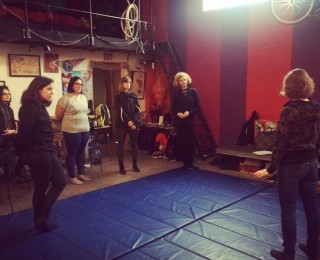
(Photo: We Bike NYC)
The non-profit Bicycle Transportation Alliance has a mission to get more women on bikes. But strangely enough, they first plan to teach women how to fall off them.
We often talk about fears and barriers to bicycling for would-be riders. Most of the time it’s about fears of riding next to traffic, getting sweaty before work, not having enough cargo space, not wanting to get rained on, and so on. But falling? It never occurred to me that would be a significant barrier until I saw an email from BTA Program Manager Nicole Davenport. She posted a message to a local email list with the subject: “Bike Falling Expert?”
“Is anyone out there really good at safely falling off their bike?” she wondered. “Would you like to help teach a group of people to safely fall off their bikes?”
I recall doing falling drills while on the cycling team in college. We’d run on a field and then dive head-first onto the grass, breaking our fall with our arms and then tumbling into a tuck-and-roll. The idea was to get our bodies familiar with landing as gracefully as possible. During a race, falls can happen in an instant. Teaching your body what to do when it happens is a key skill (and one I’m sorry to say I used more than I care to remember). But falling drills for new riders who’d only be biking in the city and for fun? That was new to me.
Advertisement
I followed up with Davenport via email to learn more. I asked why she wanted to host a falling workshop. She said the inspiration came via an Instagram post from We Bike NYC, a group that promotes women’s empowerment through bicycles.
“Falling off my bike is one of my own largest fears while riding,” Davenport shared. She also races cyclocross but doesn’t worry about falling in the mud and dirt (“It’s a bit more forgiving than pavement.”). “But when it comes to urban riding,” she said, “I do get nervous about flying over my handlebars and breaking a wrist, clavicle or my face when I hit the pavement.”
Davenport hopes her upcoming workshop teaches people “how to hurt themselves less when they take flight from their bike.” And obviously not only women would benefit from a class like this, it just so happens that Davenport is managing the BTA’s Women Bike program so she’s starting there.
Davenport is still putting things together and the workshop won’t happen until spring or summer. If you consider yourself a falling expert, or want to learn how to fall better, get in touch Davenport via email at nicole@btaoregon.org.
— Jonathan Maus, (503) 706-8804 – jonathan@bikeportland.org
BikePortland can’t survive without paid subscribers. Please sign up today.







Thanks for reading.
BikePortland has served this community with independent community journalism since 2005. We rely on subscriptions from readers like you to survive. Your financial support is vital in keeping this valuable resource alive and well.
Please subscribe today to strengthen and expand our work.
This is awesome! And it’s something that I had never considered before. I would love to learn this as well.
I remember hearing that a cycling team would practice this with each other by riding as slowly as they could on the grass and try to push each other over. Not only did it teach you how to fall, but it also was great practice balancing under poor conditions.
yep. We used to do this drill. really great practice for staying loose. We’d ride side-by-side and like you said, lean into each other… and then break free. Taught me how to always stay loose and expect contact. All that stuff serves me very well today when i ride in city traffic.
that is a balance, spacing, and positioning drill, not a crashing exercise.
It’s both!
not really, no.
It’s not a crashing exercise, you are right, I guess. But you are the only one that was talking about it being a crashing exercise. Everyone else was talking about a falling exercise.
Crash, fall… same thing.
Anyway, the point of that exercise was to not fall, not to get better at it.
That sounds like a good practice. I personally learned how to ride on a brick street and gravel, so slow, controlled riding was instilled in me from a young age.
But I have also (within the last 2 years) taken a few spills on my bike and I haven’t always fallen very gracefully. I’d like to be more prepared than that 🙂
Also, this is slightly off-topic, but it really seems that the future of biking will be heavily influenced (and perhaps even dominated) by women, which is great.
I’ve seen a huge uptick in women biking, at least in my neighborhood and places I commonly go. It’s refreshing, and women often bring up ideas and concerns and solutions that I have never even thought about.
Cool that you’re seeing that. I’m seeing the opposite. Many, many of my female acquaintances are giving up on riding.
Sounds well intentioned. But could this send a mixed message?
I had the same thought. But if falling is a concern that would-be riders express a lot, then a how-to-fall class would help bring those folks into the fold.
I’ve fallen off my bike three times since I started riding again in middle age. Two were due to my mismanagement of braking and stopping, and happened at a near-standstill. (The third was due to driver mismanagement at an intersection.) How to fall would be one thing to learn, for sure, but how to avoid falling in the most common falling situations would be even more valuable.
I was going to say the same thing. If you’re afraid of falling, learning how to avoid it is just as important. Practice braking hard with the front brake in many different conditions, surfaces, and terrain. Learn how hard you can stop when it’s wet vs dry, on a hill, on some leaves, manhole covers, or in a corner. Braking can be very quick on a bike, but you have to learn the limits to avoid a front wheel skid and how to move your weight back to avoid going over the bars — stop yourself rather than the bike.
I can’t remember the last time I caught a flat tire, but I know how to fix ’em.
Skills: they’re good.
Back in the day, twenty to thirty years ago, we used to play bike polo on grass fields during the winter months. There were enough falls to teach everyone by trial and error. Actually, it was probably a pretty good way to learn an unplanned dismount, since it was at the same slow speeds that most new riders will fall at.
When I first got a road bike ~5 years ago I blew out my front tire on the steep downhill on Pointer Rd (the one in the middle of the Hwy 26 MUP). My bike did an endo, but somehow in that instant I failed to consider that I was part of the bike, and I unclipped from the pedals, hurdled the handlebars, and landed like a cat on my feet in front of the bike.
No idea how I did it.
Just sayin’.
One time I clipped my foot on the curb getting on of a car. Everyone (Including me)was astonished as I somehow did a perfect tumble roll on to my feet.
That road is the entire reason I started commuting by MTB instead of old 10 speed. Couldn’t climb the thing in the morning and I couldn’t stop at the bottom on the way home.
I would consider this valuable, and I’m not new to cycling. I’ve laid my bike down a few times- not even at high speed or from an interaction with a car- and it can be really nerve wracking to get back out there and continue riding.
Post fall should be addressed too. In traffic it really can kick in the “fight or flight” reaction and I’ve personally sat a few people down of the sidewalk after a spill/getting hit so they can get their wits about them.
One, who is still a great friend, tried to ride away from the car that had hit them without getting any info and with several significant enough wounds to warrant some attention.
Yes! I’ve had minor crashes (fortunately all on car-lite or car-free roads) due to slippery surfaces, taking a turn too fast, unseen debris in the road, etc., and I have to say, it’s REALLY NICE when I don’t have any helpful witnesses.
One time, a person on foot came up to me and panicked and I had to spend my time reassuring them rather than sitting there for a moment and assessing myself and my bike.
There was this other time when a couple of people on foot came up to me and didn’t panic and left me alone well enough to let me take a moment to gather myself. They were a little concerned about shock, so they made me promise to eat an apple when I got home, which I did.
The times I crashed when alone, I was able to just sit in pain for a few minutes and then went about my day.
There’s an adage in mountain biking: it’s not a mountain bike ride unless there’s blood. When I mountain biked regularly, I fell regularly. If I stopped falling, it meant I needed to try more challenging terrain.
In contrast, I’ve only fallen once in five years of biking everywhere for transportation. I went to put my foot down and fell over flat because the street was severely crowned from too many layers of repaving.
So while I think it’s great to help people get over fears of falling off the bike, perhaps letting them know it’s really really rare would be a better strategy. And take them out on the dirt instead for some fun while learning to fall.
P.S. I’ve led MTB rides with newbies who were experienced equestrians. They were quick to tell me how much less painful it is to fall off a bike than a horse.
Interesting! I thought I’d mention that many martial arts, such as Judo, spend a lot of time training how to fall properly – although falling off a bicycle is a lot different, some basic principles would seem to apply: slap the pavement with your arms, keep your head from bashing the ground, etc.
I also recommend wearing some type of gloves so that you won’t get road rash if you ever DO fall.
Upright cyclists on those fancy Dutch city bikes may now continue gloating!
In almost 5 years riding my bakfiets I’ve laid that thing down more times than I can count. Even sometimes when the kids aren’t in it so I can’t blame their shenanigans. No gloating here. 😉
Nope not really. More like falling off a horse. Tuck your head and arms and try to roll into your shoulder.
Railroad tracks and loose dogs in rural areas terrify me when I’m on my bike. I suppose both are related to falling.
THESE ARE EXACTLY MY FEARS.
Railroad tracks are my #1 avoidance while biking. MAX tracks make me a bit uneasy, but 80% of the time I’m dismounting for railroads. The other 20% is a fancy ped crossing that I can ride over easy.
how about vid some of the class & post online ?
2 years ago I tried to cross into a driveway on a frosty morning. Only doing 2-3 MPH , but fell to my right. Instinctively put out my right hand to catch the fall.
Within a couple of months my right bicep ruptured. The long muscle detached from the shoulder , turning it into a monocep. 🙁
Despite reattachment surgery, it’s come loose again. Now it looks like I’m doing a Popeye flex even at rest. NO FUN. Wish I could take that fall back.
Why does a class like this need to be gender specific? That seems a little discriminating to me, everyone should learn how to fall properly, not just “women”.
“Davenport hopes her upcoming workshop teaches people “how to hurt themselves less when they take flight from their bike.” And obviously not only women would benefit from a class like this, it just so happens that Davenport is managing the BTA’s Women Bike program so she’s starting there.”
Did you even read the article?
Yep, read the article, but try putting together a men’s only class. I bet that wouldn’t go over well. Maybe I am just really jaded from previous encounters dealing with double standards. It just seems like there has been a lot of women exclusive events, classes, benefits lately.
If I had the skills, I would teach a class. Definitely not man-only though.
However, since I don’t have these skills yet, I’m excited to see these classes or events expanding.
It’s not a double standard when you use a false equivalence to make your point.
The class I did these drills in was with a men’s-only racing team. The same club sponsored a women’s racing team, and they did the same drills we did, just not with the men.
It’s not that men don’t need these skills. It’s that women seem to be more interested in the class and women often prefer to take skills classes with other women vs. in a mixed gender class. More here: http://ladyfleur.bike/2013/08/20/part-4-five-things-i-knew-about-women-bikes/
‘breaking your fall with your arms’ is actually the last thing you want to do, unless you prefer a broken collarbone to go with your hip and knee road rash.
after racing for 10+ years and riding to work for the better part of 15, several broken ribs, several cracked helmets, significant scar tissue on both elbows and knees, no 2 crashes are the same. some involve man hole covers, some involve train tracks, some involve potholes, some involve simple inattention to a seam in the pavement, some involve other people, some are solo efforts. All hurt like hell. Teaching people to fall on a mat or the grass is, I’m sorry, just not the same thing as hitting pavement at 15-40mph in different situations. It may make people feel better about commuting, but its not a skillset that’s going to come in much use down the road.
I respectfully disagree with your last point. Teaching people that bicycling may involve falling is not a bad thing (truth in advertising). Showing people that falling in controlled environments helps them reduce fear and build confidence. I think the human mind/body is often able to figure out the physiology of falling – sometimes intuitively – and repeatedly doing it in a controlled environment can build muscle memory that may come in handy at higher speeds and/or on pavement (YMMV).
You’re dead on about trying to stop the fall, though, and when I practiced I learned this quickly. I’m not nearly as race-experienced as you, but was gifted a titanium plate from an inconspicuous wet metal plate, stitches from a loose crankarm, and a split helmet when my rear tire passed me while descending a switchback. I guess ironically the controlled drills gave me the confidence to actually get into the situations resulting in the more harmful outcomes… 😉
Why’s that? I fell four times during our recent ice/snow event, and each time I landed on my hand, and suffered no injuries.
The reason I’m so confident out there is because I know how to fall, and even ditch at the right time if I have no other choice. My bike got into an accident without me last year, I hopped off and started flintstones running in a tangential direction.
I wish I’d seen this…. 🙂
Always wear gloves. A helmet may or may not be necessary (I’m not going to get into that!) but your hands *will* get hurt.
When I was a kid I fell off my bike all the time, sometimes intentionally, but that’s been 40 years….
“(I’m not going to get into that!)”
Oh yeah you are… if you’re going to give that kind of advice. I suspect I’m not the only one reading this who’s convinced that a split helmet (or two) prevented much worse outcomes, hence the willingness to wear one regularly instead of playing numbers games. Gloves? Yeah, helpful for saving skin, but did nothing to prevent my torn ligaments.
I got tied up with a cockeyed railroad crossing and went over my bars, breaking the entire back out of my helmet No controversy IMO that helmet saved my life and allowed me to ride away.
I doubt you could have practiced that fall though. The lesson is caution as opposed to fearlessness. There’s a fine line between fearless and reckless.
If women want to sign up… more power to them.
The premise strikes me as illogical though.
Step-through bikes and folding bikes are nice when you fall since the frame shape makes it easy to disentangle
I ride recumbents and would like to know how to safely fall.